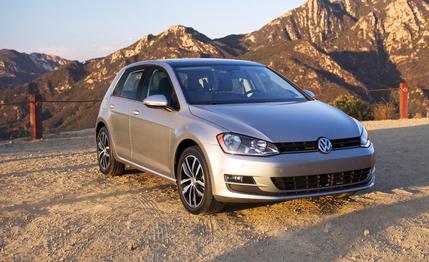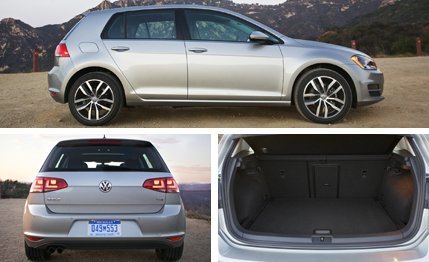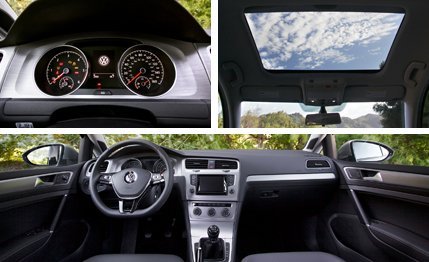
 Instrumented Test
Instrumented Test
Diesels used to be more eclectic than thrift shops in Portland. But diesels, like hipster culture, are beginning to blend into the mainstream. Walk up to the Golf TDI and almost nothing gives away its compression-ignition secret. The redesigned 2.0-liter turbo-diesel hums quietly, it idles no more loudly than some direct-injected four-cylinders, and it doesn’t smell like a diesel. A small TDI badge on the hatch and a low redline are the only telltales. But the difference between the gasoline and diesel versions becomes quite apparent if you forgo the optional automatic and stick with the standard manual transmission.
Drive the six-speed manual and the diesel’s characteristic torque and low-revving nature are impossible to ignore. There’s no lack of output, the engine is strong; a burly 236 lb-ft of torque starts shoving at 1750 rpm, and the 150-hp peak is reached at 3500 rpm. There’s a wait for the oomph when pulling away from a stop or at low speed, but the Golf surges ahead once boost builds.
The diesel’s deficit is that the power doesn’t stick around for very long. There’s little pull until the 1750-rpm torque peak and acceleration flattens out at about 4000 rpm. Slightly taller gearing compared with the gas model, helps extend the brief powerband, but you still find yourself working and concentrating on shifting to keep the engine in its short but sweet spot. The consolation is shift efforts are light, and the clutch operates with a smooth and easy motion. Opt for the $1100 dual-clutch automatic and all the shifting work is done for you, making the TDI feel quicker and less laborious in the process.


The auto-equipped oil-burner doesn’t just feel quicker than the manual, it is quicker thanks to a wider-ratio gearbox with shorter gearing in the lower cogs. Accelerating from zero to 60 mph, the manual takes 8.3 seconds to the automatic’s 7.8 seconds. But a TDI customer likely cares more about keeping the farmer’s-market tomatoes in the back from getting squashed than stomping the accelerator. Fuel economy is a far more important metric to these folks, possibly more important than determining whether the kale they just bought is locally sourced. According to the EPA, the manual diesel is rated at 31 mpg in the city and 45 on the highway (automatics nab an estimated 43 on the highway). Gas-turbo Golfs are EPA-rated at 25 mpg city and 37 highway with a manual and 25/36 with the six-speed automatic.
In 240 miles of highway and city driving, we managed 32 mpg, 2 mpg short of the number we hit with the automatic. The trip computer reported 38.9 mpg in the same period of time, but trip computers are usually very optimistic, which is why we perform an odometer calibration and measure fuel economy by how many gallons go into the car. Still, go easier on the acceleration than we did and the Golf’s fuel economy should rise into the mid-to-high-30s.
Aside from the surging power delivery and the roughly $1000 premium for the engine, little is sacrificed for the increased efficiency of the TDI version. We haven’t yet tested a 2015 Golf with the new 1.8-liter turbo gasoline engine yet, but we’re sure it would take many miles to recoup the diesel’s cost premium.


The new-generation Golf is fractionally larger than the previous version, and the cabin is more spacious and airy than before. The high-quality trim used throughout the Golf’s interior is good enough for an Audi. The vinyl-covered seats that will leave your back sweating aren’t Audi-nice, but they are supportive and provide a comfortable driving position. A firm yet compliant ride keeps all but the worst impacts at bay, even on the TDI SE’s standard 17-inch wheels. And the low-revving nature of the TDI helps keep the cabin luxury-car quiet. At 70 mph, a low 67 decibels reaches the driver’s ear.
In this latest generation, the Golf continues to climb out of the economy-car caste. It’s a solid small car with the imperturbable demeanor we usually associate with more upscale cars. The vinyl seats and badge might not have premium status, but the fit is tidy, the finishes are rich, and the design is traditional and serious. While interior space is generous, the Golf’s compact footprint remains a lot smaller than mid-size sedans such as the Honda Accord, the Toyota Camry, and the Ford Fusion. If a bigger car is what you want, Volkswagen will sell you a Passat TDI for the $28,005 as-tested price of our loaded Golf TDI SE. The base five-door Golf TDI opens at $22,815 and will rise all the way to the automatic TDI SEL which stickers at $29,915. There are larger cars to be had at those prices, but there aren’t any that are better appointed or more refined.